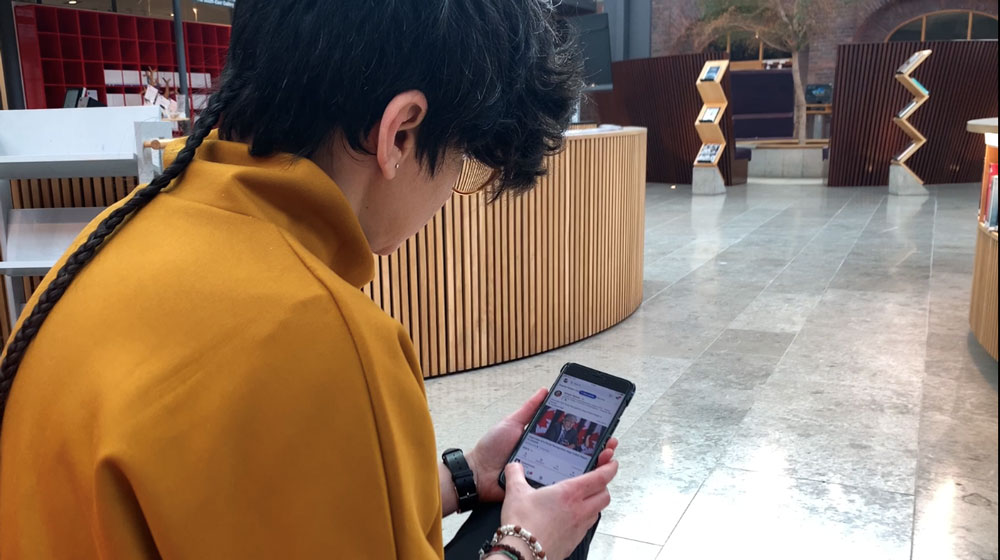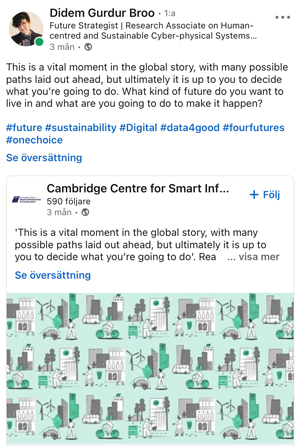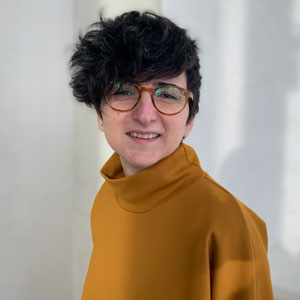LinkedIn widens the research world

Didem Gürdür Broo started to use LinkedIn for her research 5 years ago when she was still a PhD candidate at the Department of Machine design at KTH. Today, this channel plays an important part for expanding her work network and spreading her own research results. Here are her best tips.
Why did you start using LinkedIn?
I primarily wanted to follow some institutions, organizations and companies to see what they are working on. I also thought that it would be the best platform to build a network related to my research topic. All researchers want people to learn from your findings one way or the other. In addition to our publishing in scientific journals, LinkedIn is a way to build a wider audience interested in our research.
How do you use the channel?
I like to share my publications when they are available on digital libraries. I have a personal website that I write blog posts related to me, my life, my work or my hobbies (photography, sailing, diving and so on). I like sharing these through LinkedIn also. I write popular science articles related to my research, that I also share on my LinkedIn profile.
How to you talk about complex matters in a social channel?

The research work that we do is complicated. I work on cyber-physical systems. This word does not mean anything to people who are not working on this topic, so you need to use examples on how this is being used. I generally choose examples I’ve worked with, such as collaborative robots, autonomous vehicles and smart cities. I think the best way to formulate complicated matters is to practice to formulate simple posts, get feedback and do it again. And not being afraid to simplify. I am lucky to be married to a lawyer. Since she works in a completely different work environment then me, her feedback on my posts is a perfect way to evaluate myself.
When I use a link for sharing my articles for instance, I summarize the idea in the post by giving examples. Sometime I add questions such as “Are we working enough to make future cyber-physical systems sustainable?” Then I explain what the article is about. I like using hashtags. I've used Instagram for years (and have 25K followers), and have learned how to use hashtags efficiently, wich was useful for LinkedIn.
And who do you want to reach by using this channel?
For me LinkedIn has two purposes. Firstly, to keep contact with people that I know. My old work colleagues, industrial partners I've collaborated with earlier, other researchers I've met at conferences and so on. I see what they are working on and let them know what I do. Sometimes there are groups on specific topics where I want to stay up to date. Now, LinkedIn have events that people invite me to attend because we are connected.
Secondly, to follow people that have work I’m interested in; for instance well-known scientists; or organisations. I follow research institutions, a few start-up companies that I like. It is a good way to learn how they are progressing and read about their achievements.
What kind of results and response can you see from using it?
There are plenty of benefits:

- I have a diverse network from all around the world. When I check my LinkedIn feed in the morning, I can really see what is going on in the world. I have mainly a technology focused network but I am also part of organisations who works on topics such as philosophy of technology, or ethics of artificial intelligence.
- I have met people through LinkedIn I have started a project together with.
- I had coffees with people who read my popular science article and wanted to discuss how their organisation can do better.
- I have been invited to be part of organisations through my contacts on LinkedIn.
- Today, I mentor women all around the world because of this connection and we learn a lot from each other.
- If nothing else, when I share my research finding, thousands of people see it, some comments, some likes the article. It at least helps me to see that there are many who are interested in what I do.
How often do you use LinkedIn?
I check my LinkedIn every day. I sometimes I have the website open in a tab and check it more than once a day. I’m often in contact with someone through messages or having a thread going on related to a post or event.
How do you build a network?
You should start with connecting with people you already know. It is not a good practice to send invitation to people you do not know or have anything in common with. It is good to add a note to kindly inform them why you are sending and invitation. And when I have meetings with partners and it’s obvious that we will continue to work on a topic together - then I certainly try to add these people to my network.
How would you recommend a researcher to get started?
There are many useful articles to read before setting up a profile. Then I suggest to really pay attention to complete your LinkedIn profile and update it frequently. Adding your colleagues, business partners, industrial collaborators and etc is the best way to start an account. Then you can follow interesting topics and people that you find relevant, and take it from there. Like anything in life, it requires dedication, energy and consistency. In a few years you can have a decent network full of people who are really interested with what you share.
Text: Anna Gullers
Photo: Ulrika Georgsson
